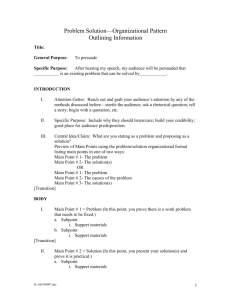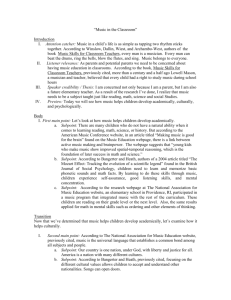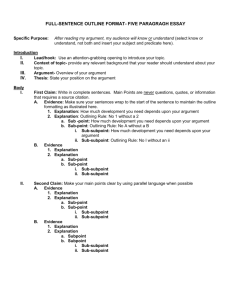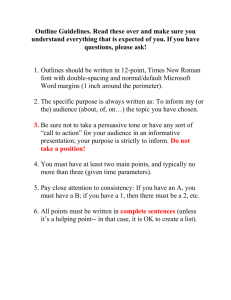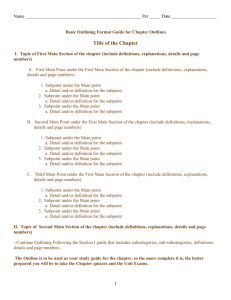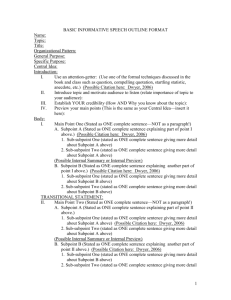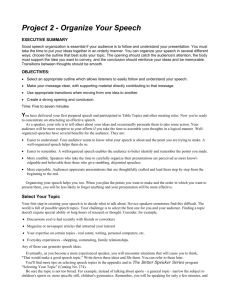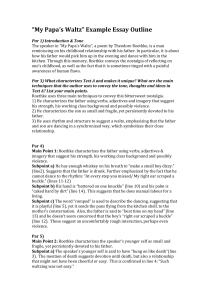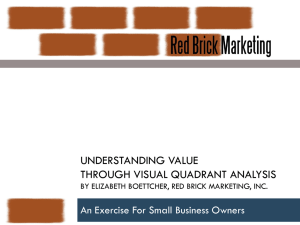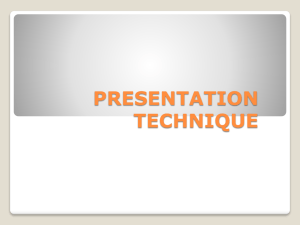Persuasive Speech Outline Template
advertisement
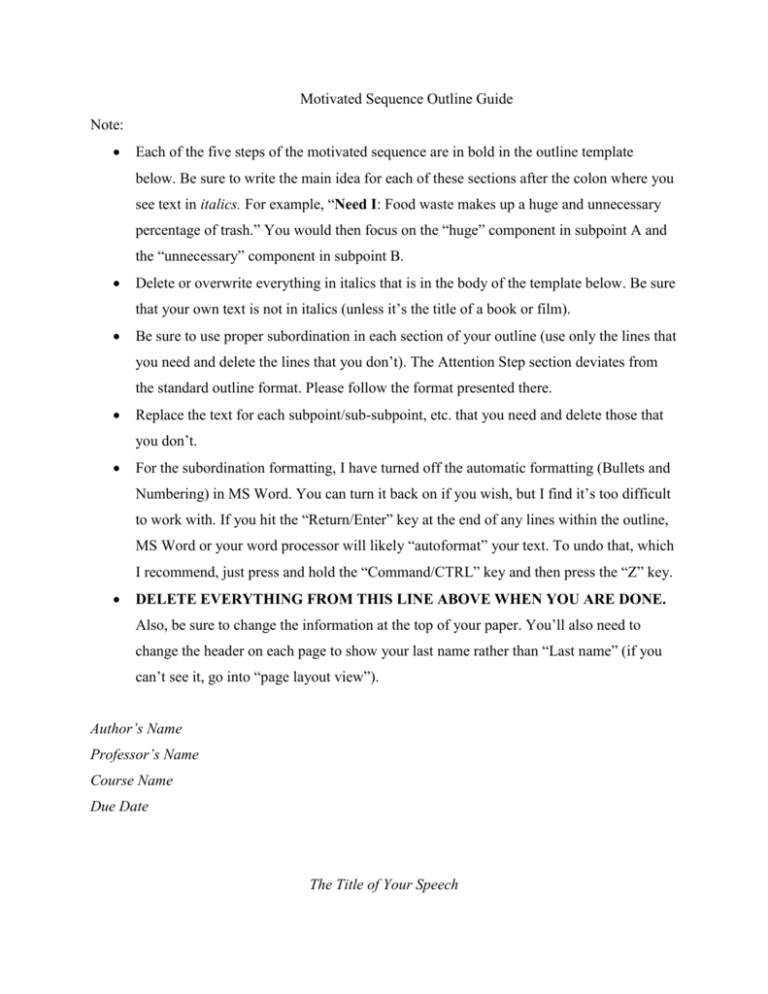
Motivated Sequence Outline Guide Note: Each of the five steps of the motivated sequence are in bold in the outline template below. Be sure to write the main idea for each of these sections after the colon where you see text in italics. For example, “Need I: Food waste makes up a huge and unnecessary percentage of trash.” You would then focus on the “huge” component in subpoint A and the “unnecessary” component in subpoint B. Delete or overwrite everything in italics that is in the body of the template below. Be sure that your own text is not in italics (unless it’s the title of a book or film). Be sure to use proper subordination in each section of your outline (use only the lines that you need and delete the lines that you don’t). The Attention Step section deviates from the standard outline format. Please follow the format presented there. Replace the text for each subpoint/sub-subpoint, etc. that you need and delete those that you don’t. For the subordination formatting, I have turned off the automatic formatting (Bullets and Numbering) in MS Word. You can turn it back on if you wish, but I find it’s too difficult to work with. If you hit the “Return/Enter” key at the end of any lines within the outline, MS Word or your word processor will likely “autoformat” your text. To undo that, which I recommend, just press and hold the “Command/CTRL” key and then press the “Z” key. DELETE EVERYTHING FROM THIS LINE ABOVE WHEN YOU ARE DONE. Also, be sure to change the information at the top of your paper. You’ll also need to change the header on each page to show your last name rather than “Last name” (if you can’t see it, go into “page layout view”). Author’s Name Professor’s Name Course Name Due Date The Title of Your Speech Last name 2 I. Attention Step: You don’t need to type anything else here. A. Attention Getter: Add your attention getter here. See tips below. You might use any of the following devices: B. C. D. rhetorical question startling statement quotation illustration or story reference to the subject reference to the occasion Reason to Listen: Add your reason to listen (WIFFM) here. See tips below. Motivate your audience’s interest in your subject. Tell them about the practical value of your information in their lives Speaker Credibility: Why should we listen to you? See tips below. Allude to any first-hand experience(s) you have had with your topic. Allude to sources of information you have consulted on your topic. The Purpose/Thesis of Your Speech: Tell the audience what you want them to do after hearing your speech. If you want to keep that a surprise, then you don’t have to “give it away,” but you should tell us what your speech will be about. E. Preview Main Points: Briefly describe what you will cover, and the order in which it will be covered. 1. Briefly describe Roman numeral II here 2. Briefly describe Roman numeral III here 3. Briefly describe Roman numeral IV here 4. Briefly describe Roman numeral V here (unless you want to surprise us with it) II. Need Step: Provide a main idea that summarizes the need or problem you are addressing. Tips: Illustration: Tell of one or more incidents to illustrate the need. Ramifications: Employ as many additional facts, examples, and quotations as are required to make the need convincingly impressive. Pointing: Show the importance of the need specifically to the members of your audience. Last name 3 A. Subpoint 1 1. Sub-subpoint 1 a. Sub-sub-subpoint 1 b. Sub-sub-subpoint 2 i. Sub-sub-sub-subpoint 1 2. Sub-subpoint 2 a. Sub-sub-subpoint 1 b. Sub-sub-subpoint 2 3. Sub-subpoint 3 a. Sub-sub-subpoint 1 b. Sub-sub-subpoint 2 B. Subpoint 2 1. Sub-subpoint 1 a. Sub-sub-subpoint 1 b. Sub-sub-subpoint 2 i. Sub-sub-sub-subpoint 1 2. Sub-subpoint 2 a. Sub-sub-subpoint 1 b. Sub-sub-subpoint 2 3. Sub-subpoint 3 a. Sub-sub-subpoint 1 b. Sub-sub-subpoint 2 C. Subpoint 3 1. Sub-subpoint 1 a. Sub-sub-subpoint 1 b. Sub-sub-subpoint 2 i. Sub-sub-sub-subpoint 1 2. Sub-subpoint 2 a. Sub-sub-subpoint 1 b. Sub-sub-subpoint 2 3. Sub-subpoint 3 Last name 4 a. Sub-sub-subpoint 1 b. Sub-sub-subpoint 2 TRANSITION: Provide a clear and obvious transition/signpost for your listener here. III. Solution Step: Provide a main idea that summarizes the solution you are addressing. Tips: Statement of Solution: Briefly state the belief, attitude, value, or behavior change you wish your audience to adopt. Explanation of Solution: Explain the details of your solution. Make sure that your proposal is understood. Theoretical Demonstration: Show how your solution logically and adequately meets the needs as presented in the Need Step. Approach this in a point by point fashion. Practical Experience: Provide actual examples of where this solution has been tried and is working to solve the need, or where this belief has been proven to be correct. If the solution has never been tried before, use an analogy to compare your solution with a similar solution that was effective. Meeting Objections: Address the claims of the opposition, and present your arguments against them. Forestall opposition to your proposal by overcoming any objections that might be raised. A. Subpoint 1 1. Sub-subpoint 1 a. Sub-sub-subpoint 1 b. Sub-sub-subpoint 2 i. Sub-sub-sub-subpoint 1 2. Sub-subpoint 2 a. Sub-sub-subpoint 1 b. Sub-sub-subpoint 2 3. Sub-subpoint 3 a. Sub-sub-subpoint 1 b. Sub-sub-subpoint 2 Last name 5 B. Subpoint 2 1. Sub-subpoint 1 a. Sub-sub-subpoint 1 b. Sub-sub-subpoint 2 i. Sub-sub-sub-subpoint 1 2. Sub-subpoint 2 a. Sub-sub-subpoint 1 b. Sub-sub-subpoint 2 3. Sub-subpoint 3 a. Sub-sub-subpoint 1 b. Sub-sub-subpoint 2 C. Subpoint 3 1. Sub-subpoint 1 a. Sub-sub-subpoint 1 b. Sub-sub-subpoint 2 i. Sub-sub-sub-subpoint 1 2. Sub-subpoint 2 a. Sub-sub-subpoint 1 b. Sub-sub-subpoint 2 3. Sub-subpoint 3 a. Sub-sub-subpoint 1 b. Sub-sub-subpoint 2 TRANSITION: Provide a clear and obvious transition/signpost for your listener here. IV. Visualization Step: Provide a main idea that summarizes the solution you are addressing. Tips: Negative Visualization: As realistically as possible, describe the conditions if your solution is not carried out. Picture the audience feeling the bad effects or unpleasantness that the failure to effect your solution will produce. Last name 6 Positive Visualization: As realistically as possible, describe the conditions if your solution is carried out. Picture the listeners in that situation actually enjoying the safety, pleasure, or pride that your proposal will produce if accepted. A. Subpoint 1 1. Sub-subpoint 1 a. Sub-sub-subpoint 1 b. Sub-sub-subpoint 2 i. Sub-sub-sub-subpoint 1 2. Sub-subpoint 2 a. Sub-sub-subpoint 1 b. Sub-sub-subpoint 2 3. Sub-subpoint 3 a. Sub-sub-subpoint 1 b. Sub-sub-subpoint 2 B. Subpoint 2 1. Sub-subpoint 1 a. Sub-sub-subpoint 1 b. Sub-sub-subpoint 2 i. Sub-sub-sub-subpoint 1 2. Sub-subpoint 2 a. Sub-sub-subpoint 1 b. Sub-sub-subpoint 2 3. Sub-subpoint 3 a. Sub-sub-subpoint 1 b. Sub-sub-subpoint 2 C. Subpoint 3 1. Sub-subpoint 1 a. Sub-sub-subpoint 1 b. Sub-sub-subpoint 2 i. Sub-sub-sub-subpoint 1 2. Sub-subpoint 2 Last name 7 a. Sub-sub-subpoint 1 b. Sub-sub-subpoint 2 3. Sub-subpoint 3 a. Sub-sub-subpoint 1 b. Sub-sub-subpoint 2 TRANSITION: Provide a clear and obvious transition/signpost for your listener here. V. Action Step: Provide a main idea that summarizes the solution you are addressing. Tips: Summary/Restatement of Main Points: Briefly review the main points you covered in your speech. Statement of Action or Attitude Change: Specifically tell your audience what it is you want them to do now. Personal Intent: Make a declaration to your audience about what it is you plan to do to further your solution. Reason to Remember/Tie Back to Introduction: Somehow refer to your attention getter. Provide your audience with a reason to remember your speech. A. Subpoint 1 1. Sub-subpoint 1 a. Sub-sub-subpoint 1 b. Sub-sub-subpoint 2 i. Sub-sub-sub-subpoint 1 2. Sub-subpoint 2 a. Sub-sub-subpoint 1 b. Sub-sub-subpoint 2 3. Sub-subpoint 3 a. Sub-sub-subpoint 1 b. Sub-sub-subpoint 2 B. Subpoint 2 1. Sub-subpoint 1 Last name 8 a. Sub-sub-subpoint 1 b. Sub-sub-subpoint 2 i. Sub-sub-sub-subpoint 1 2. Sub-subpoint 2 a. Sub-sub-subpoint 1 b. Sub-sub-subpoint 2 3. Sub-subpoint 3 a. Sub-sub-subpoint 1 b. Sub-sub-subpoint 2 C. Subpoint 3 1. Sub-subpoint 1 a. Sub-sub-subpoint 1 b. Sub-sub-subpoint 2 i. Sub-sub-sub-subpoint 1 2. Sub-subpoint 2 a. Sub-sub-subpoint 1 b. Sub-sub-subpoint 2 3. Sub-subpoint 3 a. Sub-sub-subpoint 1 b. Sub-sub-subpoint 2 Last name 9 Works Cited/References/Bibliography (this title is based on your formatting style) Put your Works Cited here by replacing this text. Follow the formatting guidelines available via our Course Resources Page or your own MLA, APA, or other formatting guidelines book. To add more references, just hit return at the end of each line (to keep the same formatting). You don’t need to number your sources. Finally, don’t provide lengthy URLs, rather provide a shortened link that we can follow to find the resource.
